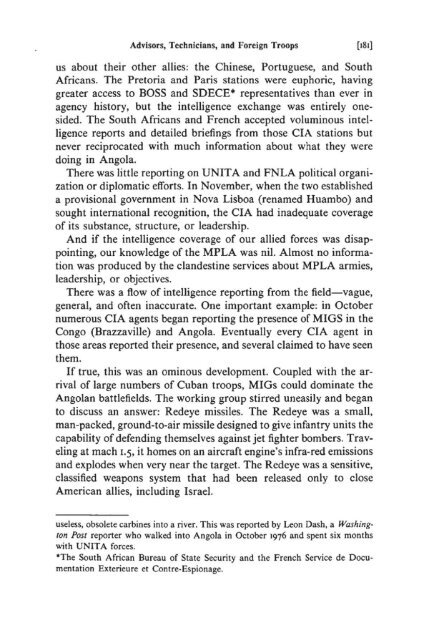In Search of Enemies - A CIA Story - John Stockwell
In Search of Enemies - A CIA Story - John Stockwell
In Search of Enemies - A CIA Story - John Stockwell
Create successful ePaper yourself
Turn your PDF publications into a flip-book with our unique Google optimized e-Paper software.
Advisors, Technicians, and Foreign Troops [181]<br />
us about their other allies: the Chinese, Portuguese, and South<br />
Africans. The Pretoria and Paris stations were euphoric, having<br />
greater access to BOSS and SDECE* representatives than ever in<br />
agency history, but the intelligence exchange was entirely onesided.<br />
The South Africans and French accepted voluminous intelligence<br />
reports and detailed briefings from those <strong>CIA</strong> stations but<br />
never reciprocated with much information about what they were<br />
doing in Angola.<br />
There was little reporting on UNITA and FNLA political organization<br />
or diplomatic efforts. <strong>In</strong> November, when the two established<br />
a provisional government in Nova Lisboa (renamed Huambo) and<br />
sought international recognition, the <strong>CIA</strong> had inadequate coverage<br />
<strong>of</strong> its substance, structure, or leadership.<br />
And if the intelligence coverage <strong>of</strong> our allied forces was disappointing,<br />
our knowledge <strong>of</strong> the MPLA was nil. Almost no information<br />
was produced by the clandestine services about MPLA armies,<br />
leadership, or objectives.<br />
There was a fl.ow <strong>of</strong> intelligence reporting from the field-vague,<br />
general, and <strong>of</strong>ten inaccurate. One important example: in October<br />
numerous <strong>CIA</strong> agents began reporting the presence <strong>of</strong> MIGS in the<br />
Congo (Brazzaville) and Angola. Eventually every <strong>CIA</strong> agent in<br />
those areas reported their presence, and several claimed to have seen<br />
them.<br />
If true, this was an ominous development. Coupled with the arrival<br />
<strong>of</strong> large numbers <strong>of</strong> Cuban troops, MIGs could dominate the<br />
Angolan battlefields. The working group stirred uneasily and began<br />
to discuss an answer: Redeye missiles. The Redeye was a small,<br />
man-packed, ground-to-air missile designed to give infantry units the<br />
capability <strong>of</strong> defending themselves against jet fighter bombers. Traveling<br />
at mach 1.5, it homes on an aircraft engine's infra-red emissions<br />
and explodes when very near the target. The Redeye was a sensitive,<br />
classified weapons system that had been released only to close<br />
American allies, including Israel.<br />
useless, obsolete carbines into a river. This was reported by Leon Dash, a Washington<br />
Post reporter who walked into Angola in October 1976 and spent six months<br />
with UNIT A forces.<br />
*The South African Bureau <strong>of</strong> State Security and the French Service de Documentation<br />
Exterieure et Contre-Espionage.


